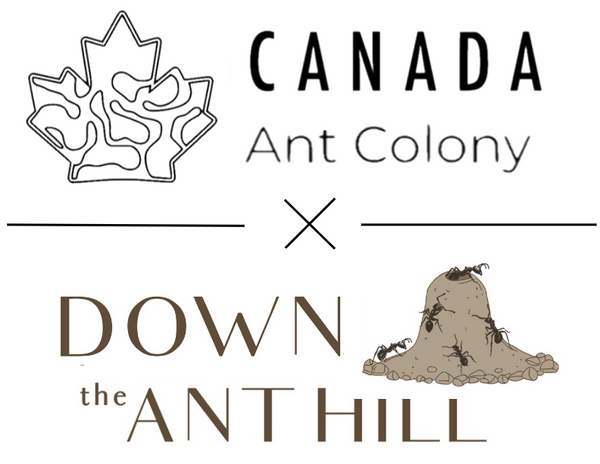The Red Carpenter Ants are easily recognizable by their vibrant red thorax. Likely originating from Canada, these ants spread downwards towards the United States and have become extremely common in the north-western states. These ants love their sugars and have very impressive majors. Their queens are also very good looking and they are very easy to care for due to their fully claustral founding stage.
If you're in Canada, you can purchase colonies of New York Carpenter Ants here. If you're in the US, you can purchase colonies of New York Carpenter Ants here.

Camponotus novaeborecensis (New York Carpenter Ant) Foragers, Credit to Antoine Guiguet
Taxonomy
Family: Formicidae
Subfamily: Formicinae
Tribus: Camponotini
Genus: Camponotus
Species: Camponotus novaeboracensis
Basic info
Origin: Canada
Habitat: Enjoys warm temperatures but doesn’t need them, I have kept them in an air-conditioned room and they have done just fine. They enjoy moist nest with a good amount of darkness.

New York Carpenter Ant with Brood (Alexis Godin)
Colony form: Strictly monogynus.
Colony size: 10.000+ workers
Colony age: 10-15 years
Founding: Fully claustral
Workers: Polymorphic (Major and minor)
Nesting: These ants dig nests into dirt and often burrow quite deep. (at least a foot). They also love living in wood and rotting materials.
Hibernation: These ants require at least 4-5 months of hibernation in 4-6 degrees celsius.
Reproduction: alates throughout May.
Appearance
Minor workers: Workers have a smaller black head and a red thorax. However I find the red colour on the minors is much less pronounced then on the majors. Their gaster is black and slightly hairy.
Major workers: Soldiers/Majors have a large black head and a very vibrant dark red thorax. Their gasters are also black and hairy.
Queens: Large black head with a red thorax. Gaster is black and has a dark maroon undertone. Also has a shiny tint on gaster.
Drones: Dark brown head with maroon thorax. Gaster is black and the legs are semi-transparent.

Camponotus novaeborecensis (Bex Goreham)
Size
Workers: 5-13mm
Queens: 14-15mm
Drones: around 6-8mm
Development time at 75F (24C)
Egg to larvae: around 10 days
Larvae to pupa: around 11-12 days
Pupae to worker: Around 10 days
Egg to worker: 31-32 days
Ant keeping information
Recommendation: Great for beginners. Very big and easy to observe.
Temperature: 14-29 Celcius
Nesting materials: Nests in dirt and wood.
Humidity: Outworld: rooom humidity, Nesting area: mostly rather dry but with a moist part
Nest types: Sand-clay farm, Ytong, acrylics and 3D-printed nests (preferably with a bottom coat of sand-clay or grout). The ants are very dry-resistant however the nest should feature a water source, like a water test tube attached to the nest.
Formicarium size: Should fit the current colony size. These ants grow not very fast but they are big and need some space.
Formicaruim accessories: Heat source (optional).
Substrate type: This species can walk well on most surfaces. Glass, vinyl tubing, acrylics, sand, clay and grout pose no issues. They can also climb vertical and upside down on glass but the larger workers may have problems with climbing steep vinyl tubing.
Behaviour
These ants are quite curious. They always investigate a sound or smell. They often only send out one or two foragers at a time and often do tandem running.
They are rather shy but if their nest is threatened they can got into berserk mode. The larger the colony, the more aggressive workers become in general. It is very enjoyable to keep these ants because of their huge size and their very impressive major workers.
Additional information
Camponotus novaeboracensis are very big and are super easy to observe which makes them a blast to keep in an acrylic nest.
This species absolutely loves sugars so it is essential to have a sugar source available at all times, for example a sugar water test tube or a feeder with maple syrup.
Camponotus novaeboracensis produce majors at a very early stage if fed well. My colony had 3 at 14 workers.
If you’re putting them into a natural set up, put your lighting outlet near the glass to produce heat and they will nest beside it.
Diet
Sugars
Camponotus novaeboracensis love honey. From my experience, they LOVE fruits.
Protein
They eat nearly anything you give them. But they love hunting fruitflies and flies.
This guide was compiled and written by Daniel Cantin of the 'Ants and Antkeeping' discord server, which can be found here. https://discord.gg/YbZGvtR3
This guide has been posted with the permission of the authors. The original article may be found here. I have also made some edits based on my own observations
